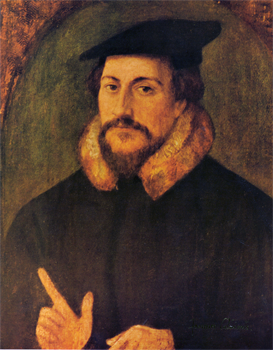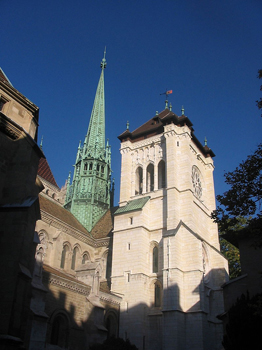For Sunday October 15, 2017
Lectionary Readings (Revised Common Lectionary, Year A)
Exodus 32:1–14 or Isaiah 25:1–9
Psalm 106:1–6, 19–23 or Psalm 23
Philippians 4:1–9
Matthew 22:1–14
For the month of October, Journey with Jesus is "Remembering the Reformation: 500 Years" with guest essays from five traditions: Catholic, Reformed, Anglican, Lutheran, and Orthodox. This week's essay is by Matthew Lundberg, PhD Princeton, and professor of religion at Calvin College in Michigan.
Reflecting on the half millennium since Luther initiated the Protestant Reformation brings to mind two obvious but countervailing observations: the Reformation’s provision of genuine spiritual and theological renewal, and its unleashing of waves of church division. At the heart of both is the question of the church’s unity, catholicity, and apostolicity — three of the so-called “marks” or “attributes” of the church in the Nicene Creed. Pondering these issues today — from my Reformed vantage point — requires that we bring a historical perspective on the past into conversation with an ecumenical outlook in the present.
John Calvin (1509-1564) has rightly become the figurehead of the Reformed traditions, though his long shadow can easily obscure key contributions made by others. Partly due to the role of his adopted city, Geneva, as a safe haven for Protestants whose lives were in danger, Calvin’s influence loomed large and continues today.
Even a cursory journey through Calvin’s Institutes of the Christian Religion (especially book 4 — I’ll use the 1559 edition) shows his conviction that the reforming church was the true church, while the Catholic Church was but a false church: “The worship of God has been deformed by a diverse and unbearable mass of superstitions. Doctrine (apart from which Christianity cannot stand) has become entirely buried and driven out” (4.2.2). Calvin draws the conclusion that opting not to belong to the Roman Catholic Church was no great loss, as it was only to opt against a false church: “In withdrawing from deadly participation in so many misdeeds, there is accordingly no danger that we be snatched away from the church of Christ” (4.2.2).
From the Catholic perspective of the day, of course, Calvin, like Luther, was a schismatic. In Calvin’s own mind, however, it was the Catholics who had departed from the true church, and from genuine catholicity and apostolicity of doctrine. Given this argument, Calvin naturally retains numerous notes of small “c” catholicity.
Following the Apostles’ Creed, he speaks of the “catholic church” as an article of faith, tying it not to an institutional hierarchy in Rome but to the seamless garment that is Christ (4.1.2). He accordingly emphasizes not the novelty of the Protestant church but its connection with the foundational resources of Christianity. This manifests itself most prominently in his appeal to the apostolic teaching as made known by scripture. It is also seen in the many insights he draws from patristic theologians such as Chrysostom and especially Augustine. In Calvin’s own mind, the church and theology he espoused were not an innovation, but mainly a return to the evangelical church of the Apostles in a Nicene and Augustinian key.
 |
|
John Calvin.
|
It is Augustinian in that Calvin (like Luther) wanted to reaffirm the primacy of grace that he thought had withered away in the Catholic Church of the preceding centuries. It is Nicene in that Calvin was happy to affirm the creeds and doctrines of the early church, provided the caveat that human traditions — even of the great councils and creeds — are fallible and always subordinate to the authority of scripture (4.9).
The churches that Calvin did so much to sculpt are thus, in many respects, just a renewed version of Nicene and Augustinian Christianity. From these foundations, though, something distinctive emerged. The Reformed tradition became an identifiable strand of the Christian story as it took shape in Zürich, Strasbourg, and especially Geneva, was given key expression in an array of notable confessions and catechisms, and migrated from Europe to the rest of the world, where it now takes innumerable cultural forms — including newer confessional statements speaking to today’s challenges (e.g., the Belhar Confession from the South African Reformed churches). It involves living out the Christian faith with a compelling emphasis on the primacy of scripture, the sovereignty of the triune God, the centrality of Christ, the ineradicable goodness of creation, the pervasiveness of sin, the utter necessity of grace for salvation and liberation, and the call upon the church to participate in God’s renewal of all creation.
To be sure, these theological convictions aren’t the sole possession of the Reformed tradition; it is more the way that they are linked to one another and the way they are articulated that lends this tradition its distinctiveness. It is, in other words, a uniqueness within catholicity. Moreover, the Reformed tradition, even in its early years, has usually kept its participation in the broader Church in view. For example, the Belgic Confession (1561) was written in part to defend the genuine catholicity of the Dutch Reformed church against its Catholic critics and persecutors. The Confession did not shy away from Reformed affirmations, nor criticisms of Roman Catholicism (or Anabaptism). But neither was it trying to define an entirely different church. Rather, it attempted to demonstrate that Reformed believers were really Christian, which would only work if it presupposed significant agreement with its persecutors.
Like any label, “Reformed” is often used not just as a descriptor but as a badge of honor. It functions not infrequently as a way of saying “the truest church.” It is perhaps no accident, then, that the Reformed churches have had a penchant for splintering and subdividing over theological disagreements.
On the one hand, any Protestant or anyone who admires, say, the Confessing Church in Germany in the 1930s cannot rule out the possibility of division sometimes being the appropriate response to fundamental disagreement. On the other hand, thinking that our expression of Christianity is the truest manifestation of authentic faith can lead prematurely to the conclusion that those who disagree with us in whatever way have diverged from the true faith; as such, we must separate from them in order to remain in the true church.
It is here that we may see a loose analogy with the idolatry on display in the golden calf story in Exodus 32. What is striking is the ease with which the people of faith substitute something of their own making for the true object of faith. Psalm 106:19-20 reflects upon the Exodus 32 passage using language of “exchange” that is later picked up by Romans 1:23-27. Perhaps one Christian form of this sin is when we “exchange” the riches of Christ and his Body for the trappings of a particular traditional or denominational identity.
 |
|
Calvin preached at St. Pierre Cathedral, the main church in Geneva.
|
Here it is worth heeding the warning of the Swiss Reformed theologian Karl Barth (1886-1968): “Once the Church has decided that apart from being a Christian and Evangelical Church, it must also be Lutheran or Calvinist, then we have to reckon with the possibility that the inevitable will happen, that when we give natural theology an inch it will want a yard, it will want everything: the Church will become more and more Lutheran or Calvinist and proportionately less and less Christian and Evangelical” (Church Dogmatics I/2:617). By “natural theology” (which he elsewhere links to idolatry), Barth means theology based on human reason, in this case reason re-stating the traditions of the church, rather than based on scripture.
The deepest motivation behind Barth’s warning is his conviction that scripture presents a constant challenge to us to reform our lives and beliefs. Perhaps an ecumenical mindset can help us to do this. Paying attention to what Christians from other traditions find in the biblical texts can help us to see things that we may have missed, just as we can help them to see things more clearly. However, even as he insisted on Christian being our proper aim and identity, Barth also affirmed that being part of a confessional tradition means being persuaded of the basic truth of its interpretation of the gospel and therefore includes a willingness to challenge other interpretations. Barth boldly (though never uncritically) owned his Reformed theological perspective, and certainly believed that it had gifts to offer to the ecumenical church, but gifts offered as Christian.
In short, being “Reformed” five hundred years after the Protestant Reformation is best pursued with a consciously ecumenical horizon — an awareness that the Triune God is at work in the world and in the other churches. It is fitting, then, that the World Communion of Reformed Churches recently signed on to the Joint Declaration on the Doctrine of Justification that the Roman Catholic Church and Lutheran World Federation hammered out in 1999. The Catholic part in the agreement constitutes an admission that there was some good reason for attempts at reform in the 16th century. And the Lutheran role suggests that the Reformation’s portrayal of the Roman Church as little more than an apostate false church was and is not fully on the mark. As many of the world’s Reformed and Presbyterian churches join their pens, via the WCRC, to the Joint Declaration, we see that at least some of the heirs of Calvin today would temper the critiques of their forebears on where the one, catholic, and apostolic church is to be found.
Considering the legacy of the Reformation after five hundred years thus leads me to gratitude and lament. Lament because it inaugurated an unprecedented surge of schisms in the Body of Christ that still prevents me from sharing the Lord’s Table with those I know are my sisters and brothers in faith. And gratitude because the Reformation brought much-needed evangelical renewal to European Christianity, and in so doing formed the churches that continue to nurture me as a disciple of Christ.





